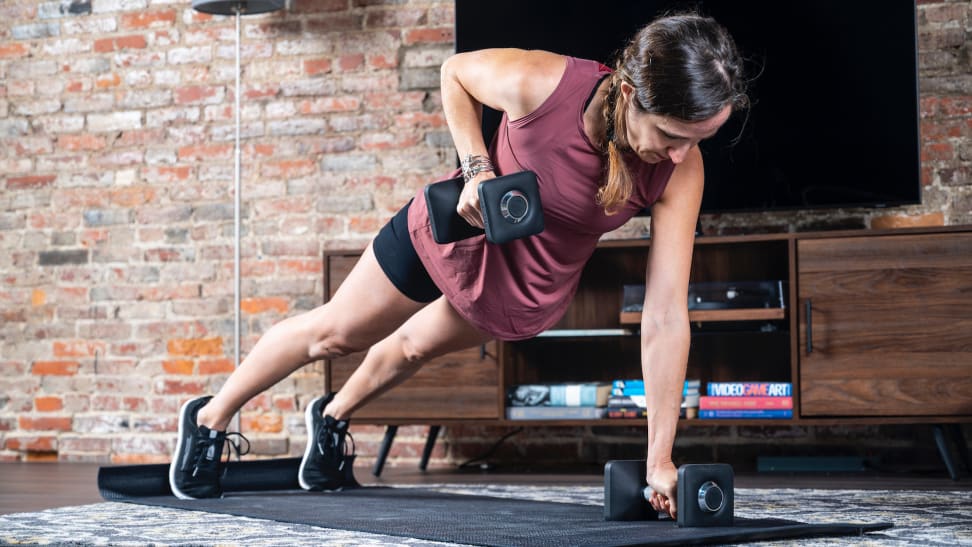 — Recommendations are independently chosen by Reviewed’s editors. Purchases you make through our links may earn us a commission.
— Recommendations are independently chosen by Reviewed’s editors. Purchases you make through our links may earn us a commission.When it comes to home workouts, you technically don’t need much to raise your heart rate. Whether it's cardio workouts and fitness classes from your favorite workout app, or simple resistance bands to tone your upper body, it's now easier than ever to turn any room of your house—or even a corner, if you're short on space—into an efficient home gym.
We've spent years testing all the best gear to find which pieces of equipment are worth your sweat, tears, and hard-earned cash. From the popular Peloton Bike+ (available at Peloton) to our favorite adjustable dumbbells, the Bowflex SelectTech 552 (available at Amazon), there's something here to target all your muscle groups without missing your gym membership or personal trainer.
This is the best home gym equipment we tested:
- Best Treadmill: NordicTrack Commercial 1750
- Best Exercise Bike: Peloton Bike+
- Best Rowing Machine: NordicTrack RW-900
- Best: Adjustable Dumbbells: Bowflex SelectTech 552
- Best Workout Mirror: Tempo Studio
- Best Yoga Mat: Lululemon Reversible Mat 5mm
- Best Foam Roller: LuxFit Premium High-Density Foam Roller
- Best Massage Gun: Therabody Theragun Elite
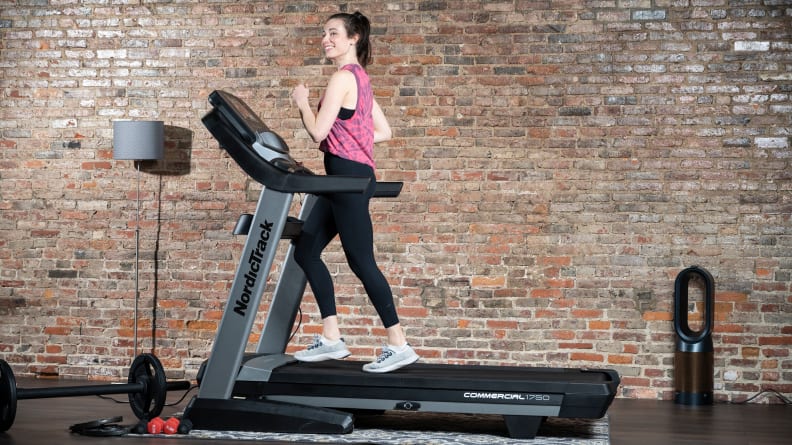

The NordicTrack Commercial 1750 treadmill is the whole package.
For anyone who wants to walk or run without leaving their home, the NordicTrack’s Commercial 1750 is the whole package. It offers speeds that range between 0.5 miles per hour (mph) to 12 mph (a 5-minute mile pace) and an incline range of -3% to 15% (yes, it goes downhill, too). The generous belt measures 22 inches wide and 68 inches long and can support up to 300 pounds. Both running and walking on it is a joy; its sturdy deck has an ideal springiness-to-firmness ratio to be gentle on joints at any pace, and it folds up when not in use. The console has a 10-inch touchscreen with additional tactile buttons to control speed, incline and decline, and to turn on its fan. Using it felt intuitive, and its metrics on the LCD display include distance, pace, speed, incline, calories burned, and time.
For those who prefer guided workouts, the 1750 comes with access to NordicTrack’s workout platform iFit, which is included for free for the first year with purchase of the treadmill. What sets iFit’s classes apart from others is that most are not filmed in a studio with the instructor also on a treadmill but instead feature instructors leading you on a guided run of an incredible outdoor destination from somewhere across the globe. When you play them on the treadmill screen, the belt automatically adjusts to match the trainer’s recommended speed and incline (though you can also go slower or faster if you want). With it, you get to follow along with runs and hikes in Thailand, Japan, Iceland, Morocco, Colorado…the list goes on. In addition to the envy-inspiring locations, the instructors are all great at chatting throughout the workout, which made them all go by relatively quickly (iFit also has studio classes, if that’s more your speed).
Pros
-
Great range of speed and incline
-
Automatic speed and incline changes
-
iFit classes are lots of fun
Cons
-
Sometimes internet connection fails
-
iFit can feel disorganized
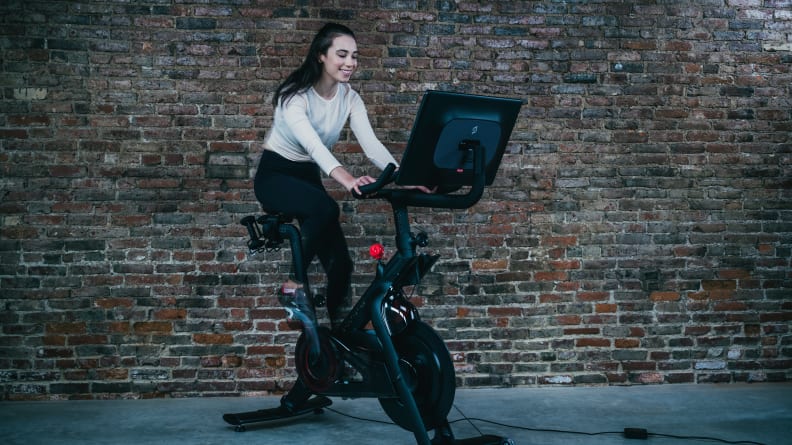

For those who enjoy an indoor cycling workout, there are any number of stationary bikes that’ll get the job done. But what made Peloton’s Bike+ stand out against all the other bikes we tested is that it seems like the easiest one to integrate into daily life. It’s simple to resize for different users’ bodies, between heights 4 feet 11 inches and 6 feet 5 inches per the specs. Its electromagnetic resistance adjusts with a twist from the large red knob and the flywheel spins silently, no matter how high you crank the tension. Peloton’s seemingly limitless live and on-demand classes are so fun that we barely noticed the time passing, even as sweat dripped down on the bike. The 23.8-inch, touch-screen tablet—the largest of the bikes we tested, and larger than the original Peloton—also displays all the metrics one might want—resistance, cadence in RPM (revolutions per minute of the flywheel), distance traveled, calories burned during class, and output measured in watts, calculated from resistance and cadence—which isn’t the case with other bikes. And, if you don’t want all the information on the screen, you can get rid of it with a tap. The class offerings are by far the most extensive of any bike we tested—after all, Peloton was the first—with up to 10 live cycling classes per day and a vast library of recorded on-demand classes, sortable by style, length, instructor, intensity, user review, and music genre (and many will show you the playlist of music before you start if you care about that sort of thing).
The Bike+ screen swivels to face away from the bike, which the original Peloton does not—a key reason we suggest springing for the pricier model. This makes it easier to see it while you do floor workouts such as yoga, HIIT, or the new bike boot camp classes, in which you hop on and off the bike to mix strength training in with spinning sets. It has an improved speaker system that delivers sound from the front of the tablet, not the rear (the original bike’s setup), which makes it easier to hear the instructors and music. Arguably its coolest feature, though, is the Auto Follow function, which changes the bike’s resistance right when the instructor calls it out in the on-demand classes (but not the live ones).
Pros
-
Auto-adjusting resistance
-
Informative and customizable metrics
-
Great sound and video quality
Cons
-
Shoes and accessories sold separately
-
Screen may wobble during hard efforts
-
Handlebars not very adjustable
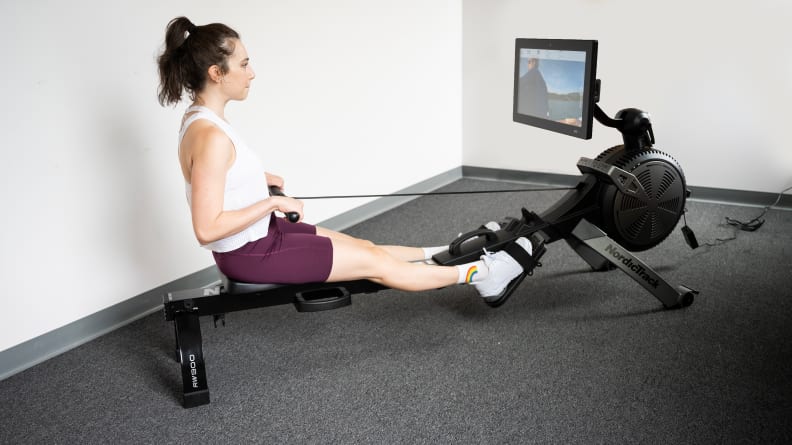

The NordicTrack RW900 is the best rower we tested.
While treadmills and bikes offer a great aerobic workout, an indoor rower (A.K.A. an ergometer, or erg) offers both aerobic and greater resistance training benefits that other big cardio exercise equipment. The NordicTrack RW 900 is our favorite rower for its seamless mechanics and connected features.
The RW 900’s electromagnetic flywheel provides 26 levels of resistance (plus 10 levels of air resistance controlled by tilting a plastic filter on top of the flywheel) and its 22-inch touchscreen broadcasts trainer-led classes in studios or on open water all over the world. Its handle has a fantastic grip held by a woven strap that felt secure, even in extra-sweaty hands. We found it easy to change the resistance, which you can do manually by swiping the screen or using the “follow the trainer” feature, which makes the machine auto-adjust to whatever resistance the instructor is using.
As for the classes, NordicTrack’s workout app, iFit, offers seemingly limitless streaming options, from in-studio bootcamp sessions in which you get on and off the rower to long rows out on open water in far-flung locations like Lake Bled in Slovenia and the Kafue River in Zambia. There are a lot of instructors, so you can poke around the offerings and find one or two whose coaching sensibilities suit your style. If you want to row to music in addition to trainer guidance, you can select from stations divided by genre, from rock to pop to old-school hip-hop. Finally, if you decide you don’t want to take a guided class (or don’t want to pay for the iFit membership), you can use the manual row setting. In either case, the same basic stats are displayed: Distance in meters, strokes per minute, split time per 500 meters, total time or time remaining in the workout, and a calorie burn estimate.
The rower folds up vertically when not in use, which puts the length measurements at about 42 inches and height measurement at about 41 inches—about the size of a medium bookshelf. It feels sturdy and well-constructed, but take note: NordicTrack set the weight limit at 250 pounds, one of the lowest of the rowers we tested.
Pros
-
Incredible classes and instructors
-
Solid construction
-
Easy-to-change resistance
Cons
-
Weight limit is lower than most
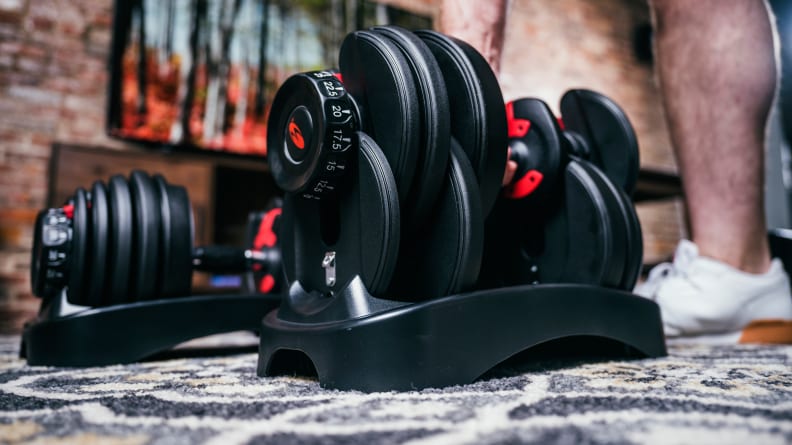

We love how easy the Bowflex adjustable dumbbells are to use.
To get the most out of your strength-training sessions, you need a variety of weight loads for different exercises that are heavy enough to challenge yourself, both at the beginning and as your muscles develop. That’s why adjustable dumbbells are a wise home-gym investment, as they range up to 50 pounds or more while taking up a tiny fraction of the space a weight rack would. After testing, the Bowflex SelectTech 552 dumbbells are our favorite adjustable dumbbells for their easy-to-use design, variety of weights, and good looks.
One of the biggest pros that sets the Bowflex dumbbells apart is how easy it is to re-rack them. Adjustable dumbbells typically come in a tray that holds the plates not in use, and when that tray is smaller, the plates have a tendency to crash into each other and get stuck while replacing the dumbbells. The Bowflex dumbbells are exceptionally easy to re-rack because the tray separates the weight plates from each other. This made for the most enjoyable experience of any of the dumbbells we tested, and is the main reason Bowflex came out on top.
The Bowflex dumbbells also have one of the widest varieties of weights, ranging from 5 pounds to 52.5 pounds and replacing 15 pairs of dumbbells. They increase in 2.5-pound increments up to 25 pounds, and 5-pound increments after that. The smaller weight increases can made a huge difference in terms of allowing you to progress more comfortably and avoid potentially straining yourself.
Pros
-
Easy to use
-
Adjust in 2.5-pound increments
-
Smooth to re-rack
Cons
-
Takes longer than some to adjust weight
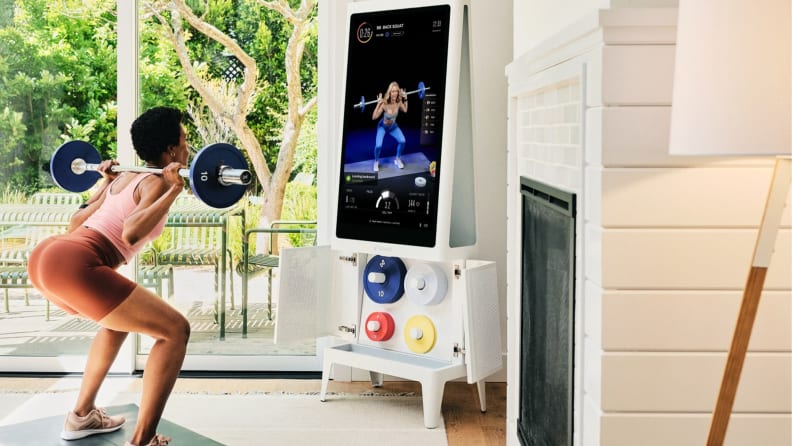

The Tempo Studio's AI-powered coaching helped put it on top.
A relatively new entry on the home gym scene, connected workout mirrors combine the streaming-classes model of Peloton with an unobtrusive screen and can provide form feedback as you go about your exercises. In our tests, The Tempo Studio came out on top, thanks to its AI-powered virtual training, a feature few other mirrors could match.
Instead of making you rely on your reflection (which, ironically, you can’t see all that well in the Tempo’s display surface), the Studio has a camera equipped with a 3D sensor that analyzes your movements to offer real-time corrections throughout your workouts and let you know when you’ve fixed your mistakes. It also counts your reps so you don’t have to. Using the Studio is simple and fun. When you first sign up, you take a quick quiz about your preferred exercise styles and goals. From there, Tempo recommends classes it thinks you’ll enjoy and designs a training plan to help you reach your goals. You can take both live and prerecorded classes and can also choose from a variety of programs such as ”two-week intro to strength” or “six-week functional fitness” should you want a more structured plan.
Every session had a variety of movements in it so they never felt repetitive, and all the instructors are fun, motivating, and knowledgeable. Though it would be easy for instructors to rely on the Tempo’s smart feedback, they still gave detailed guidance about how your moves should look and feel to help keep you on track. Tempo also aims to personalize your class experience by recommending how much weight you should lift using the included dumbbells that start at 7.5 pounds each and come with plates to load up to 45 pounds per weight. Tempo asks whether the recommendations were too light, too heavy, or just right and will adjust accordingly. As you get stronger, it suggests heavier weights, or you can manually change your settings to your preference.
Pros
-
Helpful AI-powered coaching
-
Great for strength training
-
Fun classes and motivational instructors
Cons
-
Requires you stand 6 feet from screen
-
Visual-only form feedback is easy to miss
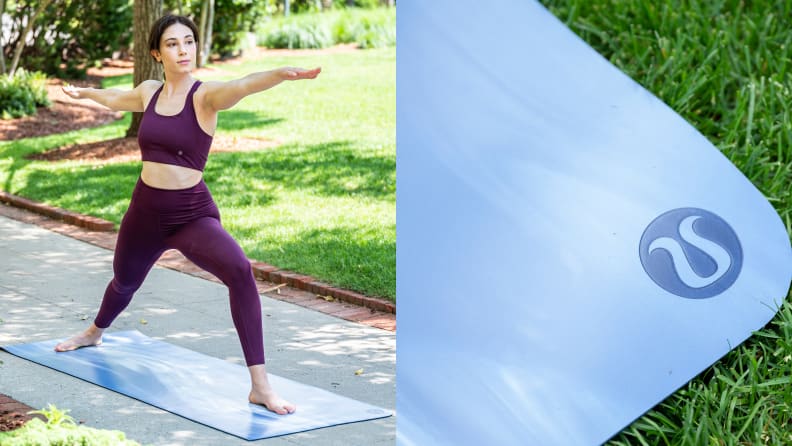

Lululemon's reversible mat aced each one of our tests.
If you do a lot of yoga or bodyweight workouts and need a cushioned surface, you can’t do any better than this classic Lululemon mat.
The 71-inch long, 26-inch wide, and 5-millimeter (0.2-inch) surface may feel dense at first, but it has just the right amount of softness to provide cushion under joints without any wobbling during balancing poses. It boasts a completely smooth, non-skid polyurethane surface and a base made of textured natural rubber, ensuring a great grip on both sides. This smooth, sturdy top layer means it's great for hot yoga, too—a yoga towel doesn't slip around too much on the mat, even if a lot of sweat drips onto it. You can firmly plant my hands and feet on the mat while switching poses or trying to hold a plank.
Because it’s so smooth, it’s easy to wipe down after a workout, though it takes some time to fully dry. And while the 5.24-pound weight can feel heavy, the mat rolls up well, which is great for portability.
Pros
-
Surface provides comfort without wobbling
-
Easy to wipe down
-
Rolls up well
Cons
-
Expensive




The Theragun Elite was the best massage gun we tested because of its ergonomic design, helpful app, and sleek design.
Arguably in the “nice to have” camp, a massage gun powers up your workout recovery, offering targeted vibration to work out tight spots in overworked muscles. And there’s a reason the name "Theragun" is synonymous with massage guns as a whole—it’s amazing at what it does.
From its ergonomic design to the educational Therabody app, and even to its sleek, professional-looking packaging, the Theragun Elite has all of its bases covered. Featuring five speeds, five attachments, and a handle that makes it easy to reach most places on the body, it provide a wide range of sensations and pressure levels that should satisfy everyone from the professional athlete to the casual runner. It's also simple to increase and decrease the intensity settings, with the small control panel at the top of the gun that can easily be toggled with your thumb.
Theragun’s triangular ergonomic handle sets it apart from the rest. Other guns don’t fit as easily in the hand, which makes reaching the back, neck, and shoulders tough, but the Theragun’s shape lets you get to those spots with ease.
But the biggest gamechanger that this product offers is Bluetooth capability with the Therabody app. The app connects to your Theragun and offers preset programs, so all you have to do is pick a warm-up or recovery treatment and the settings automatically ‘play’ right on the Theragun. When you go into the app, you can choose from different warm-ups and cool-downs for specific sports, like running, cycling, or yoga (just to name a few). You can also look for treatments that will help you with specific muscle issues, like carpal tunnel, sciatica, even “tech neck” (or neck pain caused by gazing downward at computers and phones for long periods of time). From there, you click on the treatment, make sure your Theragun is on, and the app guides you through.
Pros
-
Ergonomically designed handle
-
Bluetooth capability with app
Cons
-
Expensive
